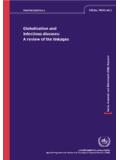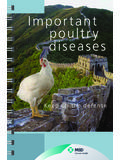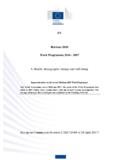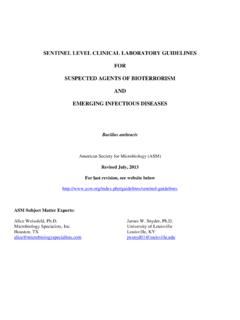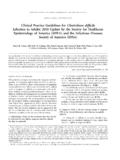Transcription of Introduction WHO Collaborating Centres for Classification ...
1 IContents WHO Collaborating Centres for Classification of Report of the International Conference for the Tenth Revision of the International Classification of List of three-character Tabular list of inclusions and four-character subcategories I Certain infectious and parasitic diseases ..I-1 II II-1 III Diseases of the blood and blood-forming organs and certain disorders involving the immune IV Endocrine, nutritional and metabolic diseases ..IV-1 V Mental and behavioural V-1 VI Diseases of the nervous system ..VI-1 VII Diseases of the eye and adnexa ..VII-1 VIII Diseases of the ear and mastoid VIII-1 IX Diseases of the circulatory X Diseases of the respiratory X-1 XI Diseases of the digestive system ..XI-1 XII Diseases of the skin and subcutaneous XIII Diseases of the musculoskeletal system and connective XIII-1 XIV Diseases of the genitourinary system.
2 XIV-1 XV Pregnancy, childbirth and the XV-1 XVI Certain conditions originating in the perinatal XVII Congenital malformations, deformations and chromosomal XVIII Symptoms, signs and abnormal clinical and laboratory findings not elsewhere XVIII-1 XIX Injury, poisoning and certain other consequences of external XX External causes of morbidity and XX-1 ii Morphology of 1 introduction A Classification of diseases may be defined as a system of categories to which morbid entities are assigned according to established criteria. There are many possible axes of Classification and the one selected will depend upon the use to be made of the statistics to be compiled. A statistical Classification of diseases must encompass the entire range of morbid conditions within a manageable number of categories.
3 The Tenth Revision of the International Statistical Classification of Diseases and Related Health Problems is the latest in a series that was formalized in 1893 as the Bertillon Classification or International List of Causes of Death. A complete review of the historical background to the Classification is given in Part 2a Instruction Manual (NCHS). While the title has been amended to make clearer the content and purpose and to reflect the progressive extension of the scope of the Classification beyond diseases and injuries, the familiar abbreviation "ICD" has been retained. In the updated Classification , conditions have been grouped in a way that was felt to be most suitable for general epidemiological purposes and the evaluation of health care. Work on the Tenth Revision of the ICD started in September 1983 when a Preparatory Meeting on ICD-10 was convened in Geneva. The programme of work was guided by regular meetings of Heads of WHO Collaborating Centres for Classification of Diseases.
4 Policy guidance was provided by a number of special meetings including those of the Expert Committee on the International Classification of disease - Tenth Revision, held in 1984 and 1987. In addition to the technical contributions provided by many specialist groups and individual experts, a large number of comments and suggestions were received from WHO Member States and Regional Offices as a result of the global circulation of draft proposals for revision in 1984 and 1986. From the comments received, it was clear that many users wished the ICD to encompass types of data other than the "diagnostic information" (in the broadest sense of the term) that it has always covered. In order to accommodate the perceived needs of these users, the concept arose of a "family" of classifications centred on the traditional ICD with its familiar form and structure. The ICD itself would thus meet the requirement for diagnostic information for general purposes, while a variety of other classifications would be used in conjunction with it and would deal either with different approaches to the same information or with different information (notably medical and surgical procedures and disablement).
5 INTERNATIONAL Classification OF DISEASES 2 Following suggestions at the time of development of the Ninth Revision of the Classification that a different basic structure might better serve the needs of the many and varied users, several alternative models were evaluated. It became clear, however, that the traditional single-variable-axis design of the Classification , and other aspects of its structure that gave emphasis to conditions that were frequent, costly or otherwise of public health importance, had withstood the test of time and that many users would be unhappy with any of the models that had been proposed as a possible replacement. Consequently, as study of the Tenth Revision will show, the traditional ICD structure has been retained but an alphanumeric coding scheme replaces the previous numeric one. This provides a larger coding frame and leaves room for future revision without disruption of the numbering system, as has occurred at previous revisions.
6 In order to make optimum use of the available space, certain disorders of the immune mechanism are included with diseases of the blood and blood-forming organs (Chapter III). New chapters have been created for diseases of the eye and adnexa and diseases of the ear and mastoid process. The former supplementary classifications of external causes and of factors influencing health status and contact with health services now form part of the main Classification . The dagger and asterisk system of dual Classification for certain diagnostic statements, introduced in the Ninth Revision, has been retained and extended, with the asterisk axis being contained in homogeneous categories at the three-character level. Content of the three volumes of ICD-10 The presentation of the Classification has been changed and there are now three volumes: Volume 1. Tabular List. This contains the Report of the International Conference for the Tenth Revision, the Classification itself at the three- and four-character levels, the Classification of the morphology of neoplasms, special tabulation lists for mortality and morbidity, definitions, and the nomenclature regulations.
7 Part 2a. Instruction Manual. This brings together the notes on certification and Classification formerly included in Volume 1 with a good deal of new background and instructional matter and guidance on the use of Volume 1, on tabulations, and on planning for the use of ICD, which was seen as lacking in earlier revisions. It also includes the historical material formerly presented in the Introduction to Volume 1. Introduction 3 Volume 3. Alphabetical Index. This presents the index itself with an Introduction and expanded instructions on its use. * * * The Classification was approved by the International Conference for the Tenth Revision of the International Classification of Diseases in 1989 and adopted by the Forty-third World Health Assembly in the following resolution: The Forty-third World Health Assembly, Having considered the report of the International Conference for the Tenth Revision of the International Classification of Diseases; 1.
8 ADOPTS the following, recommended by the Conference: (1) the detailed list of three-character categories and optional four-character subcategories with the Short Tabulation Lists for Mortality and Morbidity, constituting the Tenth Revision of the International Statistical Classification of Diseases and Related Health Problems, due to come into effect on 1 January 1993; (2) the definitions, standards and reporting requirements related to maternal, fetal, perinatal, neonatal and infant mortality; (3) the rules and instructions for underlying cause coding for mortality and main condition coding for morbidity; 2. REQUESTS the Director-General to issue the Manual of the International Statistical Classification of Diseases and Related Health Problems; 3. ENDORSES the recommendations of the Conference concerning: (1) the concept and implementation of the family of disease and health-related classifications, with the International Statistical Classification of Diseases and Related Health Problems as the core Classification surrounded by a number of related and supplementary classifications and the International Nomenclature of Diseases; (2) the establishment of an updating process within the ten-year revision cycle.
9 4 Acknowledgements The periodic revision of the ICD has, since the Sixth Revision in 1948, been coordinated by the World Health Organization. As the use of the Classification has increased, so, understandably, has the desire among its users to contribute to the revision process. The Tenth Revision is the product of a vast amount of international activity, cooperation and compromise. WHO acknowledges with gratitude the contributions of the international and national specialist groups and individuals in numerous many countries. 5 WHO Collaborating Centres for Classification of Diseases Nine WHO Collaborating Centres for Classification of Diseases have been established to assist countries with problems encountered in the development and use of health-related classifications and, in particular, in the use of the ICD.
10 It is important that countries bring to the attention of the respective Centre any significant problems they might encounter in the use of the ICD and especially when a new disease for which the ICD does not provide a suitable Classification is encountered frequently. Until now the ICD has not been updated between revisions but it has been proposed that, through the Centres , a mechanism will be introduced to provide suitable codes for new diseases where necessary. In addition to the official WHO Collaborating Centres , there are a number of national reference Centres and individual users should first consult these, or their appropriate national office, when they encounter problems. There are three Centres for English-language users. Communications should be addressed to the Head, WHO Collaborating Centre for Classification of Diseases at: Australian Institute of Health GPO Box 570 Canberra ACT 2601, Australia Office of Population and Censuses and Surveys St.












